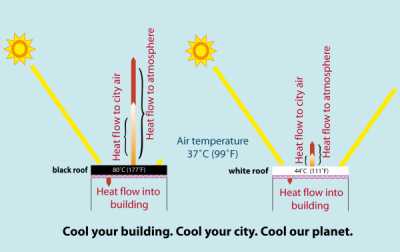Cool Science
The Problem
In light of the severity and imminence of global warming's consequences, many have proposed using geo-engineering as a means to act swiftly against climate change. Geo-engineering techniques under consideration include solar deflectors, atmospheric aerosols that increase stratospheric and/or cloud reflectivity, and advanced methods of carbon capture and sequestration, among others. However, these methods are expensive and unproven, making them high-risk propositions.
Global Cooling: Cool Surfaces
Cool roofs and pavements represent a far simpler geo-engineering approach that has a proven record of efficacy. Existing technologies can increase urban surface albedo by around 10%.1 The benefits of this capacity on buildings and cities have been well documented, but cool surfaces are increasingly being scaled up in cities across the world as a means to mitigate the urban heat island effect.11

However, the benefits of cool surfaces are not restricted to the cities in which they are utilized. By increasing the albedo, or solar reflectance (SR), of surfaces such as roofs, pavements, and cars, the surfaces absorb less solar heat and thus transmit less heat back into the environment. This process, called "negative radiative forcing," effectively cools the environment and offsets substantial quantities of greenhouse CO2. A recent study estimated that increasing the albedo of roofs and pavements in all global urban areas by 25% and 15%, respectively, offsets roughly 57 gigatonnes of CO2.12
These carbon savings can substantially slow the rate of climate change and delay the worst impacts of global warming. As more cities around the world implement cool surfaces, the global benefits will accrue even faster.
Notes:
1 Akbari H, Menon S, Rosenfeld A. 2009. Global cooling: increasing world-wide urban albedos to offset CO2. Climatic Change, 94 (3-4), 275-286.
11 Millstein D, Menon S. 2011. Regional climate consequences of large-scale cool roof and photovoltaic array deployment. Environmental Research Letters. 6:9.
12 Menon S, Akbari H, Mahanama S, Sednev I, Levinson R. 2010. Radiative forcing and temperature response to changes in urban albedos and associated CO2 offsets. Environmental Research Letters. 5:1-11.
RELATED PUBLICATIONS
2012
Levinson, Ronnen M. "The Case for Cool Roofs." 2012.
![]() PDF (205.7 KB)
PDF (205.7 KB)
Salamanca, Francisco, Shaheen R Tonse, Surabi Menon, Vishal Garg, Krishna P Singh, Manish Naja, and Marc L Fischer. "Top-of-atmosphere radiative cooling with white roofs: experimental verification and model-based evaluation." Environmental Research Letters 7.4 (2012).
2011
Menon, Surabi, and Ronnen M Levinson. "Cool roofs and global cooling: a response to Jacobson & Ten Hoeve (2011)." 2011.
![]() PDF (164.37 KB)
PDF (164.37 KB)
2010
Menon, Surabi, Hashem Akbari, Sarith Mahanama, Igor Sednev, and Ronnen M Levinson. "Radiative forcing and temperature response to changes in urban albedos and associated CO2 offsets." Environmental Research Letters 5.1 (2010).
2009
Akbari, Hashem, Surabi Menon, and Arthur H Rosenfeld. "Global cooling: increasing world-wide urban albedos to offset CO2." Climatic Change 94.3-4 (2009) 275-286.
Akbari, Hashem. "Hashem Akbari speaks to BBC Radio World Service about global cooling." BBC. 2009. Television.
2008
Akbari, Hashem, Surabi Menon, and Arthur H Rosenfeld. Equivalent CO2 avoided by reflective roofs and pavements in California. 2008.
![]() PDF (137.87 KB)
PDF (137.87 KB)
2007
Akbari, Hashem, Surabi Menon, and Arthur H Rosenfeld. "Global cooling: effect of urban albedo on global temperature." 2nd PALENC and 28th AIVC Conference. Crete, 2007. 1-5.
2006
Kaarsberg, Tina, and Hashem Akbari. "Cool Roofs Cool the Planet." Home Energy 2006: 38-41.
![]() PDF (268.96 KB)
PDF (268.96 KB)